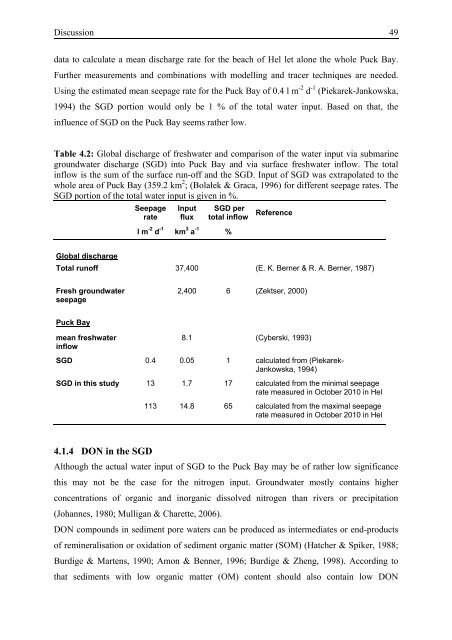Poland - IOW
Poland - IOW
Poland - IOW
You also want an ePaper? Increase the reach of your titles
YUMPU automatically turns print PDFs into web optimized ePapers that Google loves.
Discussion 49<br />
data to calculate a mean discharge rate for the beach of Hel let alone the whole Puck Bay.<br />
Further measurements and combinations with modelling and tracer techniques are needed.<br />
Using the estimated mean seepage rate for the Puck Bay of 0.4 l m -2 d -1 (Piekarek-Jankowska,<br />
1994) the SGD portion would only be 1 % of the total water input. Based on that, the<br />
influence of SGD on the Puck Bay seems rather low.<br />
Table 4.2: Global discharge of freshwater and comparison of the water input via submarine<br />
groundwater discharge (SGD) into Puck Bay and via surface freshwater inflow. The total<br />
inflow is the sum of the surface run-off and the SGD. Input of SGD was extrapolated to the<br />
whole area of Puck Bay (359.2 km 2 ; (Bolałek & Graca, 1996) for different seepage rates. The<br />
SGD portion of the total water input is given in %.<br />
Seepage<br />
rate<br />
Input<br />
flux<br />
SGD per<br />
total inflow<br />
l m -2 d -1 km 3 a -1 %<br />
Reference<br />
Global discharge<br />
Total runoff 37,400 (E. K. Berner & R. A. Berner, 1987)<br />
Fresh groundwater<br />
seepage<br />
2,400 6 (Zektser, 2000)<br />
Puck Bay<br />
mean freshwater<br />
inflow<br />
8.1 (Cyberski, 1993)<br />
SGD 0.4 0.05 1 calculated from (Piekarek-<br />
Jankowska, 1994)<br />
SGD in this study 13 1.7 17 calculated from the minimal seepage<br />
rate measured in October 2010 in Hel<br />
113 14.8 65 calculated from the maximal seepage<br />
rate measured in October 2010 in Hel<br />
4.1.4 DON in the SGD<br />
Although the actual water input of SGD to the Puck Bay may be of rather low significance<br />
this may not be the case for the nitrogen input. Groundwater mostly contains higher<br />
concentrations of organic and inorganic dissolved nitrogen than rivers or precipitation<br />
(Johannes, 1980; Mulligan & Charette, 2006).<br />
DON compounds in sediment pore waters can be produced as intermediates or end-products<br />
of remineralisation or oxidation of sediment organic matter (SOM) (Hatcher & Spiker, 1988;<br />
Burdige & Martens, 1990; Amon & Benner, 1996; Burdige & Zheng, 1998). According to<br />
that sediments with low organic matter (OM) content should also contain low DON
















